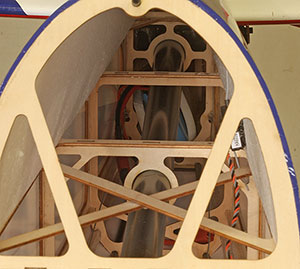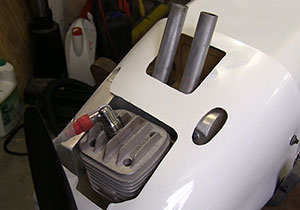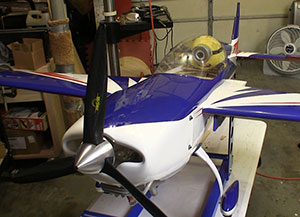



Sooner or later people will realize that Extreme Flight planes just fly great.
Text, photos and video by Tom Hintz
Flight video by Clark Ponthier
Posted – 6-20-2016
When I bought my Saito 60cc Radial and put it in my RedwingRC 50cc YAK 55 it started a series of engine swaps in my shop as I moved power plants into different air frames to hopefully improve the already great performance of these planes. That left me with my trusty DA50R without an airframe so I needed a plane that would benefit from its performance and size. While at Joe Nall (2016) we came upon the Extreme Flight 78" Extra 300. My Texas “Bill Squad” once again stepped in and an Extreme Flight 78" Extra 300 was on its way to me for this project. Thanks again guys!
The Extreme Flight 78" Extra 300 sports huge control surfaces with sharp bevels that allow for truly radical throw angles. Look inside the Extreme Flight 78" Extra 300 fuselage and you find carbon fiber stringers placed to increase the overall strength of the airframe without adding weight. They also put a second forward spar in the wings to jack up their strength to withstand the ridiculous tumbles and other insane moves that the Extreme Flight 78" Extra 300 is capable of.
The Extreme Flight 78" Extra 300 has a wingspan of 78 inches with a wing area of 1225 sq. in. and is 76 inches long. The Extreme Flight 78" Extra 300 comes in gas and electric versions so you can use 30cc-40cc gas engines or 2600-3000 Watt electric power systems. Pack all that into a projected 11.5 to 13 lbs all up weight and you have a true 3D-capable machine. My Extreme Flight 78" Extra 300 came in at nearly 16lbs with the oversized engine but it still flies with a very light feel.
I decided to hang my DA50R on the nose equipped with a carbon fiber Mejzlik 3-blade 20X12 prop (recommended by Desert Aircraft) to see if we can produce a real hot rod with which to tear holes in the sky. Incidentally, Extreme Flight includes an engine mounting template for the DA50R in the kit. I wasn’t the only one wanting to go the “more power” route with this plane.

That's important to flying the way it does.
I was happy to find heavy duty turn buckle style control surface linkages that are not only super strong, they let us dial this plane in precisely. They also send along a nice pull-pull cable set for the rudder. Another bit of hardware that I like is the tiller style tail wheel that makes mounting simple and way more durable than those %$## dual spring setups. Another nice point in the hardware is that everything is in bags that are clearly labeled and grouped for where they are installed to make finding what you need simple.
The Extreme Flight 78" Extra 300 wings have a surprisingly thin profile which should translate into relatively high overall speeds. Combine that with the substantial wing area and large control surfaces and the Extreme Flight 78" Extra 300 should have great low-speed capabilities as well as aerobatic capabilities well into the “insane” range.
All is not perfect in Extreme Flight 78" Extra 300 land. They include the rounded-shaped aluminum landing gear that is accurate to the Extra 300 but actually installing it is made way harder than is necessary. The Extreme Flight 78" Extra 300 has a fully enclosed balsa canister/pipe tunnel but the only access to try and install the four landing gear bolts (with washers) is through two oval-shaped cutouts in the top of that tunnel. Somehow you have to get those bolts down into the holes in the gear mount with one hand while holding the gear in place against the bottom of the fuse with the other hand and then get the insert nut on the bolt with what the instructions assume will be your third hand. This would have been a great place for factory-installed locking nuts secured to the aluminum angle plates inside of the fuse. I magnetized my longest hex wrench with which to carefully lower the bolts into place at the bottom of the fuse. Not fun but I got it done with only a smattering of adult language explosions.
Later after the first few flights make sure to check the landing gear to be sure the fasteners are still tight. On my Extreme Flight 78" Extra 300 the aluminum angle built into the fuse apparently gave a little under the stress of tightening the fasteners plus the landings and takeoffs. All of the fasteners were loose. In many cases that means taking the tank out to get at the oval-shaped access holes in the top of the tunnel to get at them for tightening.
Also, the rear of the fuselage is too narrow for standard-sized elevator servos. If you try to just screw them into their openings there is a big conflict between them inside. I had to double the rubber servo grommets, all with the brass inserts to get both elevator servos installed without pressing against each other.
Stuffing the DA50 in the cowl wasn't
as hard as I thought.
Installing the elevator servos and their control linkages is a little different because of the spacing between the elevators and the servos. I tried as
many configurations as I could think of and the only one that worked was installing the servos as pictured in the instructions with the output shaft to the rear, the linkage as short as I could get it and the 1.5”-long aluminum servo arm off center, cheated towards the nose of the plane a bit. Combine that with putting the linkage in the elevator control arm holes closest to the elevator and I could get full upward angle out of the elevators and nearly full throw in the down position.
Everything else about the assembly went well with no hitches in that particular git-a-long. Cutting the cowl took a little longer than normal mostly because stuffing a DA50R and a Bisson wrap-around inverted Pitts-style muffler inside of it means extensive “trimming” is needed for everything to clear. All of that is on the bottom of the plane so static looks are not compromised.
I used 2-1/2”-long standoffs when mounting the DA50R and as it all turned out I might be able to sneak some 2-1/4”-long standoffs in there and still clear the cowl but I was not able to find any standoffs that length so the cowl to spinner back plate gap is a bit over ¼”.
For servos I am using all high voltage HiTecs. I have one HS-5585-HV on each aileron and a HS-5565 on each elevator half and the rudder. The only programming, I have is enabling the Over Load Protection (OLP) with a 20% current reduction at a stall dialed in. To date I have seen nothing in the Extreme Flight 78" Extra 300 performance that suggests any control surface is stalling.

Despite the DA50, balancing was simple.
The trim flight for the Extreme Flight 78" Extra 300 turned out to be uneventful with just a couple clicks of aileron and a like amount of down elevator trim needed to fly straight and level at full throttle. Even though I had the CG set about ¼” to the rear of center in the suggested ¾” total range the Extreme Flight 78" Extra 300 showed a slight nose down arc when put on a 45-degree inverted up line, again at full speed.
The only performance issue noted was a tendency to pull left on full throttle take offs. I also noticed that it was more difficult than I expected to get the Extreme Flight 78" Extra 300 into a knife edge spin. When I added a 0.0560”-thick washer under each of the left-side motor mounts to increase right thrust a bit those issues disappeared. The Extreme Flight 78" Extra 300 seems to track perfectly now and enters knife edge spins much easier.
I like to fly a plane like this with all of the control surfaces set on “all I can get” with between 40 and 60% expo. With those settings the Extreme Flight 78" Extra 300 is generally easy to control. The exception is on landing when the Extreme Flight 78" Extra 300 gets a little “jumpy” in response to elevator and to a lesser degree rudder inputs. I had set up dual rates at roughly 60% and 40% of full throw and found that the 60% rate made landing the Extreme Flight 78" Extra 300 much easier even in gusty winds.
Originally I had intended to move the CG back to the maximum allowed in the suggested range but the violence with which the Extreme Flight 78" Extra 300 does snap rolls and tumbles at the initial CG setting has me thinking that we are far enough back right now. The combination of easy flying and an extreme level of aerobatics has convinced me the CG is fine right where I set it the first time around.
During flight testing I inadvertently tested the Extreme Flight 78" Extra 300’s sensitivity to the CG. During a series of snap rolls and knife edge spins one of my 5000mAh battery packs broke loose and was thrown down the tail section, lodging nearly all the way back, coming to rest against the elevator servos. I had no idea that had happened as the only issue I noticed in handling was that I had to add three clicks of down elevator to keep the Extreme Flight 78" Extra 300 from “squatting” tail down on approach. The thought of that much weight moving that far back should scare all of us, it did me when I saw it. Exactly how the Extreme Flight 78" Extra 300 handled such an extreme (and instant) CG change is beyond me but I was on the sticks and it flew very well. However, I will not be moving the batteries back from where they were when I set the CG. The Extreme Flight 78" Extra 300 is plenty violent in the sky when I want it to be with the CG in the correct location.
The Extreme Flight 78" Extra 300 enjoys a wide but balanced flight envelope. It is fully capable of aerobatics with a scary level of violence but is just as comfortable doing low-speed high alphas yet can be a puppy on landing with a flip of the dual rate switch. I am flying the Extreme Flight 78" Extra 300 with an Xoar 22X12 prop mounted on the DA50R and overall speed is impressive for a 3D plane without going so fast that flutter becomes a concern. Even though my Extreme Flight 78" Extra 300 came out with an all up weight (with DA50R and twin 5000mAh flight packs) pushing 16lbs it does not fly “heavy” at all.
Access to the landing gear bolts being the major exception the Extreme Flight 78" Extra 300 is an easy ARF to assemble and fly. It’s low speed characteristics combined with reduced throws make the Extreme Flight 78" Extra 300 a good choice for a first 3D machine that can be tuned to the wild side when your skills allow it.
Another good point in the Extreme Flight 78" Extra 300 favor is the street price of $479.99 (6-20-2016) which seems to be a very good value in the world of ARF’s today. If you have a 50cc motor and a moderate budget the Extreme Flight 78" Extra 300 will get you into the world of high capability aerobatics in style.
Visit the Extreme Flight 78" Extra 300 web page – Click Here
Have a comment on this review? –Email Me!